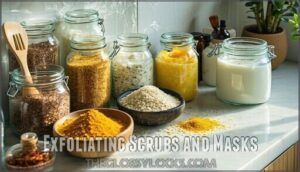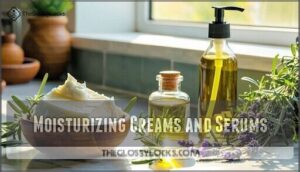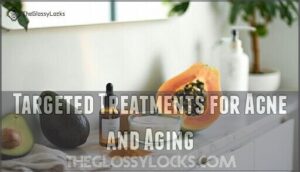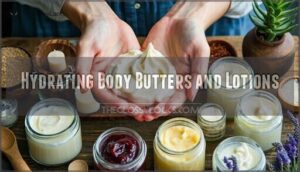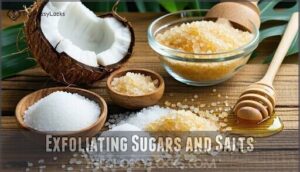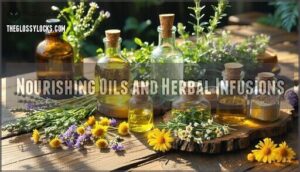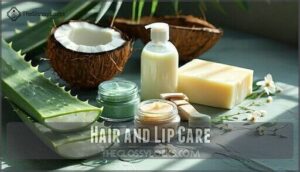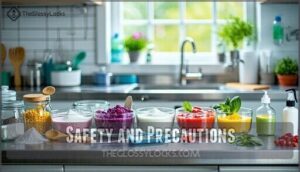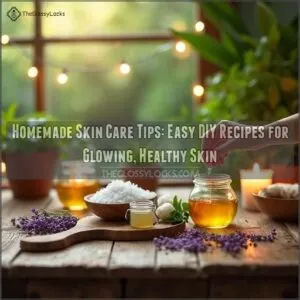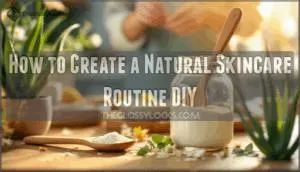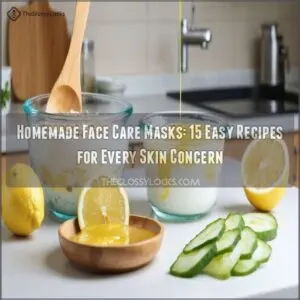This site is supported by our readers. We may earn a commission, at no cost to you, if you purchase through links.
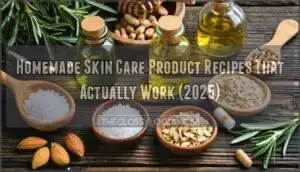 You can create effective homemade skin care product recipes using simple kitchen ingredients that often work better than expensive store-bought options.
You can create effective homemade skin care product recipes using simple kitchen ingredients that often work better than expensive store-bought options.
Start with basic recipes like honey and oatmeal face masks for gentle cleansing, or mix coconut oil with sugar for body scrubs.
Essential ingredients include carrier oils (jojoba, sweet almond), natural exfoliants (coffee grounds, sea salt), and active ingredients like tea tree oil or vitamin E.
Always patch test new recipes on a small skin area first. Customize formulations based on your skin type—dry skin benefits from heavier oils while oily skin prefers lighter, astringent ingredients.
The secret lies in understanding which ingredient combinations create synergistic effects for maximum results.
Table Of Contents
- Key Takeaways
- Natural Skin Care Basics
- Face Care Recipes
- Body Care Recipes
- Hair and Lip Care
- Advanced Skin Care Recipes
- Safety and Precautions
- Frequently Asked Questions (FAQs)
- What are the best ingredients for homemade skin care?
- How do I make my own skin care product?
- What are the only 4 ingredients that work in skincare?
- How to make a homemade skin care serum?
- How do I create my own skincare product?
- What is the best homemade skincare?
- What are the only 3 skincare products you need?
- How do you make homemade skin care products?
- What is the easiest skincare product to make?
- How can I test a recipe for allergies?
- Conclusion
Key Takeaways
- You’ll save money and control ingredients by using simple kitchen staples like honey and oats, coconut oil, and shea butter instead of expensive store-bought products
- You can customize recipes for your specific skin type—oily skin benefits from clay and tea tree oil, while dry skin needs heavier oils like avocado and argan
- Always patch test new recipes on a small skin area first and store homemade products in clean, dark containers to prevent contamination and extend shelf life
- Start with basic formulations like sugar scrubs or honey masks, then gradually experiment with advanced treatments targeting specific concerns like aging or acne
Natural Skin Care Basics
You’ll discover that making your own skincare products costs way less than buying fancy brands while giving you complete control over what touches your skin.
These natural recipes work just as well as store-bought versions, often better, because you’re using fresh ingredients without harsh chemicals or mystery additives, providing you with complete control.
Benefits of Homemade Recipes
With homemade skin care, you’re looking at serious cost savings compared to department store brands.
You’ll cut chemical exposure while gaining customization options that match your exact skin needs.
Natural ingredients like honey and oats deliver real results without synthetic additives.
Plus, DIY skincare supports sustainability by reducing packaging waste.
It’s budget-friendly skincare that actually works.
Many products contain harmful chemical exposure that can disrupt the endocrine system.
Essential Ingredients and Tools
Before diving into DIY recipes, you’ll need the right building blocks.
Carrier oils like jojoba and sweet almond form your base, while essential oils add therapeutic benefits.
Natural exfoliants such as oats and sugar provide gentle scrubbing power.
Basic DIY tools include measuring spoons, mixing bowls, and a small whisk.
Proper storage solutions like dark glass containers preserve your homemade creations’ potency and freshness.
To understand carrier oils’ advantages, research their properties and learn about the benefits of using essential oils.
Customizing Recipes for Skin Types
Your skin’s unique needs determine which natural ingredients work best for you.
Oily skin benefits from clay-based masks and tea tree oil, while dry skin craves shea butter and avocado oil.
Sensitive skin requires gentle ingredients like oatmeal and chamomile.
Combination skin needs targeted treatments for different areas.
Mature skin responds well to antioxidant-rich oils like rosehip and argan.
Face Care Recipes
Your face deserves the same care you’d give a prized garden – with the right homemade recipes, you can nourish it naturally while saving money.
These face care formulas use simple ingredients like honey, oats, and natural oils to cleanse, exfoliate, and moisturize more effectively than many store-bought products, which helps to nourish it.
Exfoliating Scrubs and Masks
Your skin sheds dead cells daily, making exfoliation a game-changer for revealing fresh, glowing skin underneath. DIY exfoliation boosts product absorption while giving you complete control over ingredients.
Dead skin cells are your glow’s biggest enemy—scrub them away to reveal the radiant skin hiding underneath.
As a result, you can experience the exfoliation benefits of improved skin texture and brightness.
- Sugar scrubs work well for most skin types, but brown sugar is gentler than white
- Oatmeal-honey masks provide gentle exfoliation perfect for sensitive skin without irritation
- Yogurt-based recipes offer lactic acid for chemical exfoliation that dissolves dead cells naturally
Recipe customization lets you target specific concerns—add turmeric for brightening or keep it simple with basic scrub ingredients.
Moisturizing Creams and Serums
After cleansing away dead skin cells, your face craves proper hydration.
Cream ingredients like shea butter and jojoba oil deliver deep moisturization, while face serum provides lightweight hydration levels perfect for layering.
Natural face moisturizer recipes blend water and oil phases for stability.
Application techniques matter—serums absorb first, then moisturizer locks in benefits.
Recipe customization targets your dry skin needs effectively.
Plant-based oils offer skin benefits and more, such as anti-inflammatory and antibacterial properties.
Targeted Treatments for Acne and Aging
Beyond basic moisturizing, targeted treatments tackle specific concerns head-on.
Tea tree oil reduces acne lesions by 49% through antibacterial action, while avocado masks boost collagen production for antiaging benefits.
- Natural acne treatment: Mix honey with cinnamon for blemish control – both ingredients fight bacteria and calm inflammation
- Antiaging skincare: Combine papaya and yogurt for cell renewal through gentle alpha-hydroxy acid exfoliation
- Acne scarring: Apply diluted rosehip oil nightly to fade marks and promote skin regeneration with vitamin C
Fine lines don’t stand a chance against homemade skin care formulas.
Body Care Recipes
Your body deserves the same luxurious care you give your face, and these DIY recipes deliver professional-quality results at a fraction of the cost.
From rich shea butter blends that melt into thirsty skin to energizing coffee scrubs that leave you glowing, you’ll discover how simple kitchen ingredients can transform your daily routine.
Hydrating Body Butters and Lotions
Rich body butters transform winter-weary skin into silky smoothness. You’ll love how Shea Butter Benefits include vitamins A and E for deep moisturization.
Give your skin the royal treatment with shea butter’s vitamin-packed richness that melts away winter’s harsh effects.
Master emulsifying techniques by slowly adding oil infusions to melted butters while whisking. Achieve perfect lotion consistency by adjusting ratios—more oils create lighter textures.
Consider exploring a body butter recipe for inspiration. Store your DIY skincare creations in airtight containers using proper storage tips for maximum freshness.
Exfoliating Sugars and Salts
Your body’s natural renewal process gets a boost when you create homemade skin care with the right exfoliating ingredients.
Sugar scrub types work gently for sensitive skin, while salt scrub types provide deeper cleansing.
Mix coarse sea salt with coconut oil for tough areas like elbows. Fine sugar blends perfectly with honey for delicate zones.
Remember proper exfoliation frequency and DIY safety—test patches first before applying face scrubs broadly, ensuring your skin care routine is both effective and safe.
Nourishing Oils and Herbal Infusions
The right carrier oils transform your homemade skin care routine.
Argan and jojoba oils deliver deep nourishment while rosehip provides antioxidants for aging skin.
Essential oils like lavender enhance herbal properties through better skin absorption.
Oil infusions using calendula or chamomile create concentrated treatments.
Shea butter’s properties can reduce wrinkles.
These natural ingredients offer superior carrier benefits compared to synthetic alternatives, providing deep nourishment, antioxidants, natural ingredients, and superior carrier benefits.
Hair and Lip Care
Your hair and scalp deserve the same natural care as your face, and homemade shampoos can cleanse without stripping away essential oils that keep your locks healthy.
Natural lip balms protect your delicate lip skin from harsh weather while providing long-lasting moisture that commercial products often can’t match.
Natural Shampoos and Conditioners
Creating natural shampoo and hair conditioner transforms your hair care routine while protecting scalp health.
These plant-based formulas work effectively for all hair types through careful ingredient sourcing and proper DIY preservation methods.
Essential components for hair DIY success:
- Natural shampoo base – liquid castile soap with coconut milk
- Hair conditioner blend – apple cider vinegar and jojoba oil
- Shampoo bar option – goat’s milk soap with essential oils
- Hair conditioner bar – cocoa butter for moisture and shine
Vegan options include plant-based ingredients that restore pH balance naturally.
Homemade Lip Balms and Scrubs
Your lips deserve attention beyond basic haircare routines. DIY lip balm offers winter protection while controlling ingredients for sensitive skin. Simple coconut oil scrubs provide gentle DIY exfoliation without harsh chemicals.
| Recipe Type | Key Ingredients | Primary Benefits |
|---|---|---|
| Basic Lip Balm | Beeswax, coconut oil, vitamin E | Deep lip hydration techniques, long-lasting moisture |
| Coconut Oil Scrub | Coconut oil, sugar, honey | Removes dead skin, natural DIY exfoliation |
| Lemon Balm Balm | Lemon balm oil, cacao butter, beeswax | Soothes cold sores, antimicrobial protection |
| Flavored Balms | Essential oils, natural extracts | Flavor customization, aromatherapy benefits |
| Exfoliating Scrub | Brown sugar, olive oil, vanilla | Gentle buffing, scrub ingredients work together |
These lip care recipes cost pennies compared to store brands. You’ll know exactly what touches your lips, avoiding questionable additives. These recipes also align with sustainable skincare practices. The lip balm benefits include barrier protection and customizable flavors that commercial products can’t match.
Hair Masks and Leave-in Treatments
Your hair deserves the same attention as your face. Hair masks penetrate deeper than regular hair conditioner, delivering intense hair nourishment to damaged strands.
Leave-in treatments protect throughout the day. Consider your hair types when choosing DIY ingredients – dry hair loves honey and coconut oil, while oily scalp health improves with clay masks.
Treatment duration matters: apply masks for 20-30 minutes, following proper application tips for maximum hair growth benefits.
Advanced Skin Care Recipes
Once you’ve mastered basic skincare recipes, you’re ready to tackle more sophisticated formulations that target specific concerns like wrinkles, dark spots, and congested pores.
These advanced recipes combine multiple active ingredients to deliver professional-level results at a fraction of the cost.
Anti-Aging and Brightening Treatments
Looking beyond basic hair and lip care, your skin deserves targeted wrinkle cream formulations that actually deliver results.
Collagen boosters like pomegranate oil contain Omega-5 fatty acids that retain skin structure. Antioxidant power from vitamin C brightens hyperpigmentation while supporting wrinkle reduction.
Create a skin brightening mask using turmeric and honey for age spot fading. Combine argan oil with green tea for antiwrinkle skincare that improves skin elasticity and promotes skin tone evening naturally.
Soothing and Calming Masks and Serums
While anti-aging treatments target time’s effects, irritated skin needs immediate relief.
Sensitive skin care requires gentle formulas that provide natural hydration without triggering reactions.
These homemade facial masks and serums calm inflammation while delivering moisture your skin craves.
- Oatmeal Honey Mask: Blend ground oats with raw honey for redness reduction and irritation relief
- Cucumber Aloe Serum: Mix fresh cucumber juice with aloe vera gel for instant cooling comfort
- Chamomile Rose Water Toner: Steep chamomile tea with rose petals for skin calming properties
- Avocado Yogurt Mask: Combine mashed avocado with plain yogurt for this hydrating face mask that soothes
Exfoliating and Detoxifying Recipes
While calming treatments address irritation, exfoliating face scrub recipes tackle deeper skin renewal.
Your skin sheds millions of cells daily, making regular exfoliation essential for healthy turnover.
| Ingredient | Best For | Frequency |
|---|---|---|
| Sugar scrubs | Dry, sun-damaged skin | 2-3x weekly |
| Oatmeal | Sensitive skin exfoliation | 1-2x weekly |
| Clay masks | Oil control, detoxification | Weekly |
Sugar scrub benefits include natural AHAs that boost cell renewal.
Clay mask types like bentonite absorb excess oil while delivering detoxifying ingredients.
Remember: over-exfoliating damages your skin barrier, so stick to recommended frequencies for ideal skin detox results.
Safety and Precautions
Creating your own skincare products can be incredibly rewarding, but safety should always come first when you’re mixing ingredients in your kitchen.
You’ll want to understand proper handling techniques and storage methods to avoid skin reactions, contamination, or ingredient degradation that could turn your homemade miracle cream into a disaster, which is why proper handling is crucial.
Safe Handling and Storage of Ingredients
Your skincare creations work best when you treat natural ingredients like fresh produce. Store oils and butters in cool, dark places to prevent rancidity. Label everything with dates since ingredient shelf-life varies widely.
Clean hands and tools prevent contamination. Keep water-based recipes refrigerated and use preservatives for longer storage.
For pregnant users, remember to check for safe skincare options. Store products away from children’s reach for safety.
Troubleshooting Common Skin Care Issues
Even experienced DIY enthusiasts occasionally encounter skin reactions or product failures.
When irritation strikes, don’t panic—most issues have simple solutions that’ll get you back on track quickly.
- Irritation Relief: For acne, eczema, or sensitive skin flare-ups, dilute recipes with more carrier oil, reduce essential oil concentrations, or switch to gentler ingredients like oatmeal instead of baking soda
- Allergy Concerns: Patch test new ingredient substitutions on your inner wrist for 24 hours; if you have oily skin but react to tea tree oil, try witch hazel instead
- Product Shelf-Life: Store homemade products in the refrigerator to extend freshness, and toss anything that smells off, changes color, or separates—your dry skin deserves fresh, effective treatments
Frequently Asked Questions (FAQs)
What are the best ingredients for homemade skin care?
Think of your kitchen as nature’s pharmacy – just like ancient healers used simple ingredients to heal wounds, you can create powerful skincare with what’s already in your pantry.
Shea butter, jojoba oil, honey, and oats form the foundation of effective homemade skincare products.
How do I make my own skin care product?
Start by choosing quality base ingredients like shea butter, carrier oils, and essential oils.
Mix them following simple ratios, test on small skin patches first, and store in clean containers for freshness.
What are the only 4 ingredients that work in skincare?
You’ll find that retinoids, sunscreen, moisturizers, and gentle cleansers form skincare’s foundation.
These four proven ingredients address aging, protection, hydration, and cleansing—everything your skin truly needs to stay healthy and glowing.
How to make a homemade skin care serum?
Mix lightweight carrier oils, add potent actives, blend carefully.
You’ll create custom serums targeting specific concerns like aging or hydration.
Start with jojoba or rosehip oil, then incorporate vitamin E for stability and preservation.
How do I create my own skincare product?
Creating your own skincare product is simpler than you’d think.
Choose quality ingredients like carrier oils, essential oils, and natural additives.
Mix them properly, test on small skin patches first, and store in clean containers for freshness.
What is the best homemade skincare?
Nothing transforms your skin like homemade honey masks and oatmeal scrubs.
You’ll get powerful results using natural ingredients that target your specific skin concerns without harsh chemicals or expensive price tags.
What are the only 3 skincare products you need?
You’ll truly thrive with just three essentials: a gentle cleanser, a quality moisturizer, and broad-spectrum sunscreen. These three powerhouses tackle cleansing, hydration, and protection—everything your skin actually needs daily.
How do you make homemade skin care products?
Like a chemist in your kitchen laboratory, you’ll blend natural ingredients to create skincare magic.
Start with simple recipes using carrier oils, essential oils, and natural bases like honey or oats for customized solutions.
What is the easiest skincare product to make?
A simple sugar scrub is your best bet.
Just mix three tablespoons of sugar with one tablespoon of olive oil.
This gentle exfoliant removes dead skin cells instantly and moisturizes simultaneously.
How can I test a recipe for allergies?
Perform a patch test by applying a small amount of your recipe to your inner forearm.
Wait 24-48 hours and watch for redness, itching, or swelling before using it on your face.
Conclusion
Despite what you might think, making your own skincare doesn’t require a chemistry degree or expensive equipment.
You’ll create effective homemade skin care product recipes using simple kitchen ingredients that rival commercial products.
Start with basic formulations and gradually experiment with advanced combinations as you gain confidence.
Remember to patch test everything and store products properly.
Your skin will thank you for the natural, personalized care you’re providing.
These recipes prove that effective skincare can be both affordable and rewarding.
- https://shop-good.co/blogs/blog/natural-beauty-ingredients-benefits
- https://www.theskininstitute.org/natural-skin-care-ingredients/
- https://www.venustreatments.com/en-gl/blog/spa-from-home-diy-recipes-for-at-home-skincare/
- https://www.tasteofhome.com/collection/homemade-beauty-recipes/
- https://www.thesoapery.co.uk/blogs/news/4-easy-diy-skincare-recipes

